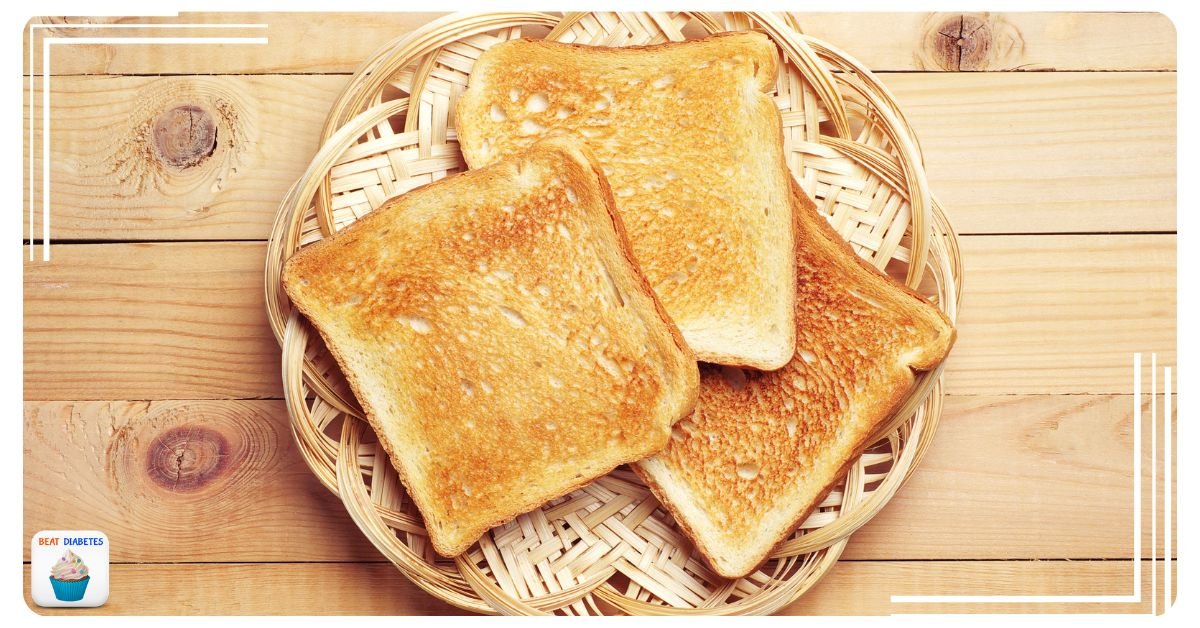Last Updated on June 14, 2023 by Dr Sharon Baisil MD
If you are a diabetic and wondering whether toast or bread is a healthier choice, this post is for you. While both options have their own set of benefits, choosing the right one can make a big difference in managing your blood sugar levels. In this blog, we will compare the nutritional benefits of toast and bread, discuss the differences in carb content between them, and explore healthy alternatives like quinoa toast. We will also give you some creative ideas for healthy toast options that diabetics can enjoy guilt-free. So if you are looking to make an informed decision about whether to choose toast or bread, read on for all the information you need to know.
Is Toast Healthier than Bread for Diabetics?
For diabetics, toasted bread with a lower glycemic index is generally better than plain bread. Whole-grain bread with high-fiber ingredients like oats and bran, as well as sprouted or sourdough bread, can help regulate blood sugar levels. Gluten-free options made with whole grains and non-GMO ingredients are also worth considering.
Nutritional Benefits of Toast
When it comes to choosing the best bread option for diabetics, toast seems to have an edge over white bread. Toasted bread has a lower glycemic index compared to plain bread, which can help regulate blood sugar levels better. What’s more, toast is often made with whole-grain bread that provides more nutrition. Adding healthy fat sources like nut butter or eggs can make it even better! Also, toast is ideal for those who want to keep an eye on their calorie intake as it’s usually toasted with less butter or oil compared to the traditional slice of bread.
Low Glycemic Index
When considering toast vs. bread for diabetics, it’s important to note that a low glycemic index plays a crucial role in regulating blood sugar levels. Diabetics should opt for whole-grain toast over white bread as it has a lower glycemic index and helps prevent blood sugar spikes. Additionally, the high fiber content in whole-grain toast aids digestion and reduces the risk of heart disease. Eating toast made from whole-grain bread can be an empowering choice for those with diabetes looking to manage their insulin levels effectively.
High Fiber Content
When managing diabetes, choosing the right kind of carbohydrates is essential. Toast made from whole-grain bread is a great option compared to white bread because it has a lower glycemic index and glycemic load and provides more nutrition in terms of dietary fiber. Dietary fiber helps regulate blood sugar levels in diabetics and promotes feelings of fullness while assisting with weight management.
Choosing whole-grain bread over white bread is crucial for maximum nutritional benefits. Toasting the bread further reduces its glycemic index as well. Whole-grain toast with toppings like nut butter or avocado can provide healthy fats and proteins too.
Nutritional Benefits of Bread
Bread is an excellent source of nutrition for diabetics seeking to sustain their energy levels throughout the day while managing blood sugar levels. In addition to being rich in fiber, bread can also be fortified with essential nutrients such as iron and B vitamins that support optimal health. If you’re looking for a delicious bakery option, consider trying whole grain bread for added nutrition benefits and to help manage blood pressure.
By selecting from various types of bread available, one can tailor their carbohydrate intake to fit within their dietary plan. Doing so will help prevent undesirable blood glucose spikes and crashes that contribute to inflammation and hypertension. Opting for whole-grain or wheat bread over white flour varieties provides added nutrition with lower glycemic indices.
Differences in Carb Content
When it comes to managing blood sugar levels in diabetics, choosing the right type of bread is crucial. While toast may have a lower carb content than regular bread due to its reduced moisture content, white bread made from white flour should be avoided as it lacks fiber.
Whole grain bread, on the other hand, is an excellent choice for diabetics as it is a good source of dietary fiber that promotes feelings of fullness and helps regulate blood sugar levels. Choosing whole grain options can also provide maximum nutritional benefits such as vitamins and minerals that are essential for maintaining overall health. It’s essential to opt for low glycemic index options that help manage blood glucose levels effectively.
Whole Grain Options
For those with diabetes, choosing the right kind of bread is crucial in managing blood sugar levels. Opting for whole-grain bread instead of white bread or toast can provide health benefits such as regulating blood sugar levels and improving insulin sensitivity. Not only do whole grains contain more fiber, vitamins, and minerals than their white counterparts, but they also keep you feeling full for longer periods of time which reduces the risk of overeating. When selecting a suitable type of bread, look out for at least 3 grams of fiber and carbohydrate content per slice and avoid added sugars or refined flour. Incorporating whole-grain bread into your diet can lead to a healthier lifestyle for those living with diabetes.
Sourdough vs. Rye Bread for Diabetics
Choosing the right type of carbohydrate can be crucial for managing blood sugar levels in diabetics. When comparing bread and toast, sourdough and rye bread come out as better options due to their lower glycemic index (GI), higher fiber content, and more nutrients. Sourdough’s fermentation process reduces its GI while retaining nutrition. On the other hand, rye bread contains plenty of fiber that helps regulate blood sugar levels. Whole-grain varieties provide around 3 grams of fiber per slice without added sugars or refined flour.
The American Diabetes Association recommends choosing whole-wheat or whole-grain bread, whole wheat bread, over white flour-based products to promote healthy digestion, regulate insulin response, prevent blood sugar spikes, reduce inflammation, and manage hypertension risks. Additionally, it is important to note that sourdough and rye bread have a lower glycaemic index, making them a better option for managing blood sugar levels in diabetics.
Quinoa Toast and Other Alternatives
Choosing between toast and bread for diabetics can be challenging. If you’re looking for a healthier substitute for traditional bread options like white bread varieties that tend to be low in nutrition and high in starches that spike blood sugar levels quickly. Fortunately, quinoa toast is a great alternative that provides essential nutrients such as healthy fats, fiber, and protein that help regulate digestion and keep blood glucose levels steady.
Sweet potato toast also makes for an excellent option as it contains complex carbohydrates that take longer to digest than white flour products linked with inflammation and hypertension. Avocado toast is another option rich in monounsaturated fats beneficial for heart disease prevention. It’s vital to monitor portion sizes while snacking on wholesome choices like these.
Healthy Toast Snack Ideas for Diabetics
If you’re looking for healthy toast ideas that won’t spike your blood sugar levels, start by choosing the right type of bread. Whole-grain bread is a better option compared to white bread because it contains more nutrition and fewer calories while being high in fiber content.
Opt for low-sugar toppings like avocado, nut butter, or eggs instead of sugary spreads or jam. Not only do these add flavor to your toast but also provide essential healthy fats and proteins that help keep you feeling full longer. To enhance the taste without adding salt, use herbs and spices like cinnamon or turmeric. You can also incorporate protein-rich toppings such as smoked salmon or tofu to make your toast even more filling and nutritious. Remember to pay attention to portion sizes and monitor blood sugar levels when incorporating toast into your meal plan.
Avocado and Tomato Toast
Looking for a nutritious breakfast option for diabetics? Avocado and tomato toast can be a great choice! The healthy fats of avocado help regulate blood sugar levels while the antioxidants from tomatoes keep inflammation at bay. So swap your regular white bread with whole-grain bread or toast to lower glycemic index as well as carb intake. Try this delicious recipe today!
Greek Yogurt and Cinnamon Toast
Enjoying a healthy breakfast is essential for anyone managing diabetes. One great breakfast option for diabetics is Greek yogurt and cinnamon toast. This dish packs in plenty of nutrition while also keeping you feeling full throughout the morning. Begin by lightly toasting a slice of whole-grain bread (preferably whole wheat or rye).
Spread a tablespoon of almond butter on the toast and sprinkle half a teaspoon of cinnamon over it. Top it all off with a generous dollop of creamy Greek yogurt (about ¼ cup), along with some sliced banana or fresh berries for an extra burst of flavor and nutrients. Not only does this meal taste great but it also contains healthy fats that can help regulate blood sugar levels. Additionally, it contains around 20-25 grams of carbohydrates, which is an important consideration for those managing their blood sugar levels.
Smoked Salmon and Cream Cheese Toast
Looking for a nutritious and delicious breakfast option that’s suitable for diabetics? Smoked salmon and cream cheese toast should be on your radar! This dish packs in plenty of protein (thanks to the smoked salmon) along with heart-healthy omega-3 fatty acids. Meanwhile, the cream cheese adds calcium without any added sugar or carbs. To add even more nutrients (and some satisfying crunch), consider topping your toast with sliced cucumbers or tomatoes. With this lean-protein-packed meal in your arsenal, you’ll be better equipped to manage diabetes while supporting your overall heart health and bloodstream.
Almond Butter and Berries Toast
Looking for a yummy breakfast option that’s diabetic-friendly? Try almond butter and berries toast! This dish combines two superfoods: almond butter, a great source of healthy fats and protein, and nutrient-rich berries with low sugar content. Together these ingredients can regulate blood sugar levels while satisfying your taste buds. Almond butter is well-known for its nutritional value, providing healthy fats that keep you feeling full longer than white bread or other sources of carbs. And the rich fiber content in berries aids digestion while preventing blood sugar spikes. So why not try this easy-to-make breakfast recipe today with wheat flour? Don’t forget to pack some berries as a snack for later! You can store the berries in the freezer for later use.
Spinach and Feta Toast
Adding spinach and feta to your toast can be a great alternative for diabetics who are looking to add some nutrition to their diet. Sauteing spinach in olive oil with garlic and spreading it over toast with crumbled feta cheese is a delicious way to get healthy fats, protein, fiber, and vitamins. This combination offers a lower glycemic index compared to white bread or starchier options that could cause blood sugar spikes. With many health benefits from whole grain bread, fiber-rich spinach, and heart-healthy feta cheese, this toast recipe can help manage diabetes, support heart health, and keep you feeling full for longer.
Takeaway and Further Reading
When choosing between toast and bread for diabetics, toasted bread may be the better option due to its lower glycemic index. But not all bread is created equal, and whole grain varieties have more fiber and nutrients than their white counterparts. When considering which type of bread to include in your diet, it’s crucial to keep track of portion sizes and consult with a registered dietitian or healthcare provider for personalized nutrition advice. By making informed choices about the types of carbohydrates you consume, you can help manage your blood sugar levels and reduce your risk of complications like insulin resistance and heart disease.
Frequently Asked Questions
References
- https://www.ncbi.nlm.nih.gov/pmc/articles/PMC3317179/
- https://www.ncbi.nlm.nih.gov/pmc/articles/PMC2584181/
- https://pubmed.ncbi.nlm.nih.gov/19857068/
- https://www.cdc.gov/diabetes/basics/type2.html
- https://academic.oup.com/nutritionreviews/article-abstract/67/4/188/1901012
- https://link.springer.com/article/10.1007/s40520-019-01392-3#
- https://journals.plos.org/plosone/article
- https://nutritionj.biomedcentral.com/articles/10.1186/s12937-016-0207-4








